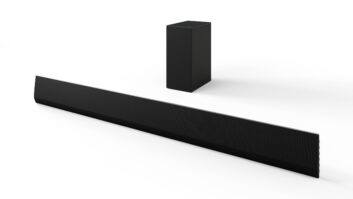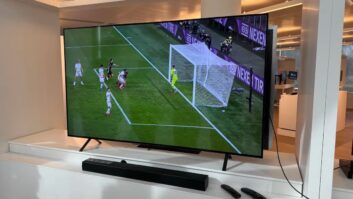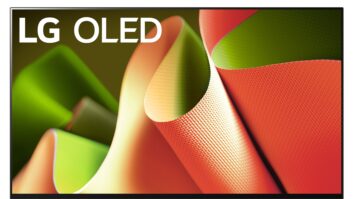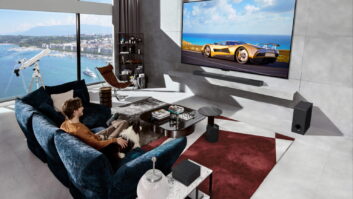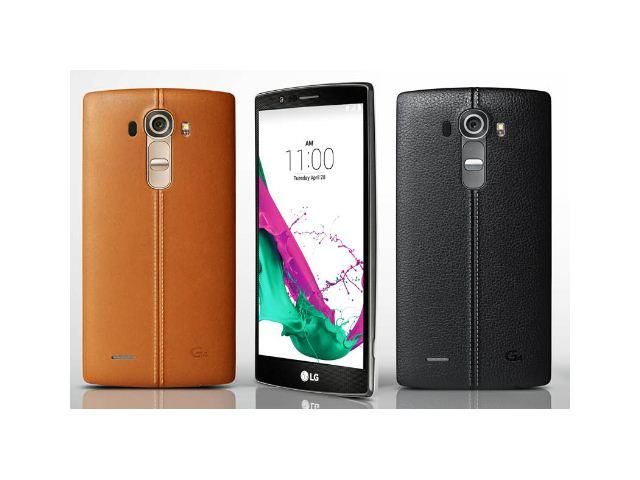
New York – LG promises its largest smartphone-promotion campaign yet to support the launch of its flagship G4, which packs D-SLR camera capabilities, quantum-dot-like IPS Quantum display, and leather-back option.
The Android 5.1 phone is also the industry’s first phone with hexacore processor, incorporating Qualcomm’s 64-bit 1.6GHz Snapdragon 808.
Pricing wasn’t disclosed during a launch event at 1 World Trade Center in Manhattan, but the 4G LTE phone with 5.5-inch display will be available in the U.S. in late May and early June through all four national carriers and U.S. Cellular, a Korea-based executive told TWICE. Sprint put June availability on its versions, including a version with black-leather back. U.S. Cellular announced availability sometime in June, and T-Mobile said it would offer the G4 in the spring.
The LG executive said the company “needs to spend more money on promotion” to ”continue growing market share” and, as a result, will promote the G4 more aggressively than previous G series phones. Promotion will include the industry’s first global promotion enabling consumers worldwide to trial the device on an invite-only basis before it’s available. A total of 2,500 Wi-Fi-only trial versions will be available to U.S. consumers starting mid-May.
LG’s U.S. market share grew to 8 percent of all smartphone subscribers ages 13 and up for the three-month period ending January, comScore surveys show. That’s up from 7.4 percent in the quarter ending last October and 6.6 percent for the quarter ending December 2013, when LG held a fourth-place share. LG’s share rose to third place after Samsung and Apple in the three months ending January.
The new device is positioned as providing “a unique experience that is simple to use for the average consumer yet still offering something new for expert users,” said Juno Cho, president/CEO of LG Electronics Mobile Communications.
Through its four arced sides, leather-back option in six color choices, and updated UI, the phone delivers “character and originality” along with usability, Cho said. The arced sides make it more comfortable to grip, and they deliver 20 percent greater durability when dropped compared to square phones, he said.
Consumer research also found that most consumers value battery life more than thinness, so rather than shave off a few millimeters by incorporating a small non-removable battery, the company offers a 3,000mAh removable battery, said Frank Lee, director of LG Electronics Mobile Communications in the U.S.
The phone is also positioned as offering high-performance camera capabilities that make it a “legitimate option if you don’t have your digital SLR with you,” Lee said. LG feels free to promote the phone as a D-SLR alternative because it does not sell digital cameras as do other mobile-phone makers that are also consumer electronics companies.
Here are the details of key phone functions:
Camera: With upgraded camera features, said Cho, the G4 represents “the closest we have come to emulating what we see with our naked eye.”
The main 16-megapixel camera, upgraded from the G3’s 13 megapixels, comes with f/1.8 aperture, which delivers 80 percent more light than the f/2.4 aperture on most phones, added Lee. The light is delivered to a 2.6-inch sensor, 40 percent larger than the G3 sensor, to deliver excellent pictures in low light, he said. Optical image stabilization (OIS) has been improved through such enhancements as z-axis stabilization to deliver faster focusing.
The world’s first color-spectrum sensor on a smartphone reads color frequencies emanating from an object to see colors as the picture taker sees them. The phone also features a separate IR sensor to detect objects. The combination enables the flash to adjust its color temperature and white balance to produce a natural result, Lee continued. The feature is particularly useful when taking pictures under overcast skies, he said.
As LG’s first phone with a fully manual camera mode, the G4 lets users select white balance, ISO, shutter speed and the like while simultaneously capturing jpg- and RAM-format images. The latter can be edited on a computer.
The front camera’s resolution grows to 8 megapixels from 2.1 and features an improved gesture shot , which lets users repeat a hand gesture to take four pictures two seconds apart.
Other camera features include laser autofocus for 0.276-second focusing and 0.6-second camera launching. Like before, it offers4K video capture and 120fps 1080p slow-motion video capture and playback.
To store all those RAW images, the G4 combines 32GB of embedded memory with a microSD slot that supports current 200GB cards and will support 2TB cards when available.
Display: To view the camera’s high-resolution pictures and videos, the phone sports the industry’s first IPS Quantum display, “which more closely matches DCI standards” to deliver 20 percent more color gamut than conventional LCD panels, said Lee. The display technology is similar to quantum-dot technology used in select TVs but delivers thinner displays, Lee said.
Like before, the display is quad HD, offering 2560 by 1440 pixels and 538 PPI, but a new liquid crystal technology boosts brightness by 25 percent, and a UV photochemical treatment improves contrast ratio by 50 percent.
Battery life: Despite a more powerful camera, display, and processor, the G4’s power consumption is 10 percent lower than that of the G3, thanks to multiple enhancements. Both phones feature 3,000mAh battery. LG reduced battery drain through such technologies as separate graphics RAM, which enables the main processor to sleep when users are viewing still pictures on the device. The phone also lets users know if “rogue apps” are drawing power when the display is off. The phone delivers more than a day of use on one charge.
User interface: The company’s UX 4.0 offers multiple enhancements compared to the previous UX, including ability to automatically create event albums based on time and location. Users can also sort pictures by day, month and year. A calendar-event “pocket” places memos, tasks, and appointments into a specific date.
Other features: The phone is the first ever to enable sensor-assisted positioning to deliver more accurate positioning of users who are indoors or moving between tall buildings, said Qualcomm executive chairman Dr. Paul Jacobs, who appeared at LG’s launch event. Sensors used include Wi-Fi, accelerometer, and barometer (for altitude).
The phone also incorporates MirrorLink, which enables the display of a simplified G4 user interface on the in-dash touchscreen of a phone-connected car radio. The feature will be available in select global markets.
The phone, like its two predecessors, decodes high-resolution 192/24 FLAC and wav files, but LG representatives didn’t know whether the phones also incorporate 192/24 DACs.




